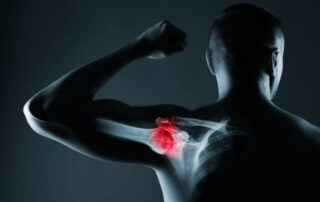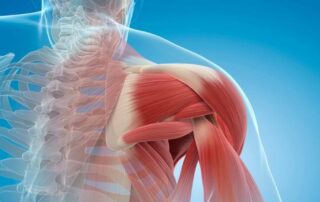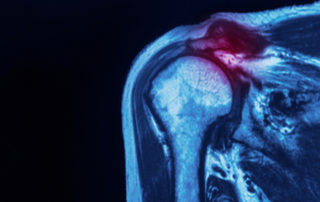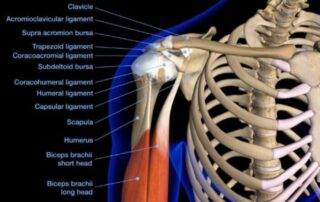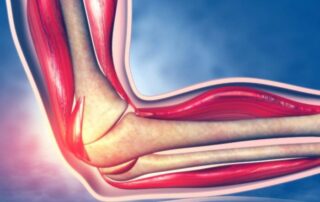Shoulder Specialist
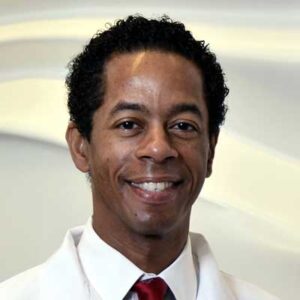
Do you have catching, grinding or shoulder stiffness? Do you participate in throwing sports or activities with repetitive overhead motions? If so, you may have loose bodies in your shoulder joint. Loose bodies are caused by degrading cartilaginous tissue that lines the end of the bones and breaks off into the shoulder. Loose bodies can be removed arthroscopically. Arthroscopic shoulder specialist, Doctor Riley J. Williams provides diagnosis as well surgical and non-surgical options for patients in Manhattan, Brooklyn, New York City and surrounding areas who are experiencing symptoms of loose bodies in their shoulder. Contact Dr. Williams’ team today!
What are loose bodies in the shoulder?
The glenohumeral joint, one of the three main shoulder joints, is the articulation between the head of the humerus (upper arm bone) and the glenoid socket of the scapula (shoulder blade). Repetitive use of this shoulder (throwing, pitching, serving) or shoulder trauma (dislocations, falls) can cause the cartilaginous tissue that lines the end of these bone to deteriorate. This deterioration can generate small free pieces of cartilage or bone that “float” in the intra-articular (joint) space. These fragments can become lodged within the joint space and can cause mechanical symptoms in the shoulder (locking, catching). Some individuals may experience a sharp and sudden pain in the shoulder that can make joint movement difficult. Dr. Riley J. Williams, orthopedic shoulder specialist serving patients in Manhattan, Brooklyn, New York City, NY and surrounding areas, has the knowledge and understanding, as well as substantial experience, in treating patients who have experienced loose bodies in the shoulder.
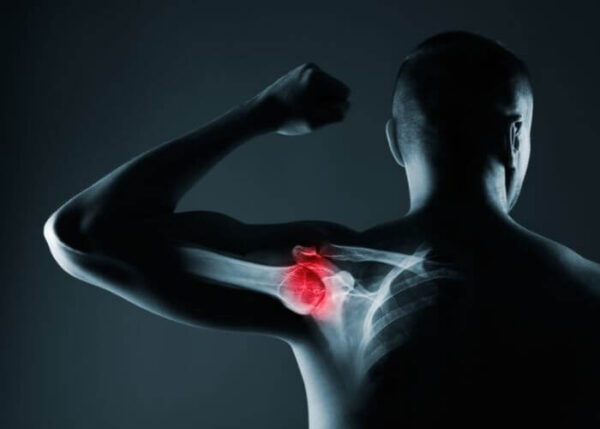
What are the symptoms of loose bodies in the shoulder?
The most common complaint of loose bodies in the shoulder is moderate to severe shoulder pain, however many individuals do not report any symptoms at all. Other symptoms of loose bodies in the shoulder include:
- A “catching” or “locking” sensation with joint movement
- Shoulder stiffness
- Decreased range of motion of the affected shoulder
- Shoulder instability
- Pain
How are loose bodies in the shoulder diagnosed?
A comprehensive medical history will be obtained by Dr. Williams and includes an assessment of shoulder injuries or a history of shoulder conditions. Dr. Williams performs a thorough physical examination involving specific shoulder movements and tests. Diagnostic imaging, such as x-rays and magnetic resonance imaging (MRI), can confirm the diagnosis of loose bodies and identify damage to the other structures of the shoulder joint.
What is the treatment for loose bodies in the shoulder?
Non-surgical treatment:
Upon confirmation of the presence of loose bodies in the shoulder conservative therapeutic measures are implemented. Immobilization of the shoulder with a sling or other device is encouraged to limit joint movement may be recommended for a brief period. Pain and inflammation can be managed with a combination of rest, ice, and non-steroidal anti-inflammatory medications (NSAIDs). If oral medications fail to alleviate the pain or inflammation, corticosteroid injections may be administered. When appropriate, a physical rehabilitation program can restore shoulder mobility and range of motion.
Surgical treatment:
If conservative therapies fail to alleviate the symptoms, surgical intervention may be necessary. The loose bodies are removed during shoulder arthroscopy (minimally invasive surgical procedure using an arthroscope and specialized surgical instruments). This simple surgical technique is performed using sedation and regional anesthesia. This arthroscopic approach reduces the risks of infection and blood loss while also shortening the recovery period. Minimal sling use is needed, and patient usually recovery with 6 weeks following the procedure.
For more information on loose bodies in the shoulder, or the excellent treatment options available, please contact the office of Dr. Riley J. Williams, orthopedic shoulder specialist serving Manhattan, Brooklyn, New York City, NY and surrounding areas.
Shoulder Acromioplasty – Subacromial Decompression Doctor

Are you experiencing shoulder pain and pinching, especially when lifting the arm or performing overhead tasks? If so, you may have subacromial impingement, or an inflamed rotator cuff. Shoulder acromioplasty is a surgical treatment used to relieve shoulder pain caused by subacromial impingement. Doctor Riley J. Williams provides acromioplasty and other shoulder treatment options for patients in Manhattan, Brooklyn, New York City and surrounding areas who are experiencing shoulder impingement. Contact Dr. Williams’ team today!
What is shoulder acromioplasty or subacromial decompression?
Shoulder acromioplasty is a surgical procedure that is performed to relieve shoulder pain associated with subacromial impingement or rotator cuff disease. The acromion is part of the scapula (shoulder blade) and is the “roof” of the shoulder that protects the rotator cuff. Impingement syndrome is characterized by a lack of space between the rotator cuff and acromion process. This lack of space causes the rotator cuff tendon to rub on the undersurface of the acromion. Acromioplasty involves shaving away part of the acromion to create space. This additional space relieves pressure on the rotator cuff upon shoulder movement. Dr. Riley J. Williams, orthopedic shoulder surgeon, serving Manhattan, Brooklyn, New York City, NY and surrounding areas, has extensive experience in performing shoulder acromioplasty and other shoulder procedures.

Why is subacromial decompression performed?
The rotator cuff envelopes the top of the humeral head and is comprised of muscles and tendons. The cuff rests underneath the acromion. Osteophytes (bone spurs) can develop on the underside of the acromion which decreases the effective space in which the rotator cuff can function. The additional acromion bone causes catching and painful irritation of the rotator cuff. Irritation of the subacromial bursa (bursitis) can also occur in these circumstances. Removal of the osteophytes relieves the irritation on the rotator cuff. The acromion can impinge or rub against the rotator cuff or bursa (fluid filled sac aiding in reduction of friction in joints), especially during overhead movements. Shaving away a small part of the acromion allows more room for movement between the rotator cuff and acromion. This space can alleviate pressure that causes pain and irritation. Rotator cuff disease and shoulder impingement syndrome are commonly observed in individuals who participate in overhead focused athletic activities such as swimming, baseball, water polo or weightlifting.
How is subacromial decompression performed?
Shoulder acromioplasty is performed using light sedation and regional anesthesia; this arthroscopic procedure is done in the outpatient setting. Arthroscopic surgery utilizes small incisions in the shoulder into which Dr. Williams inserts a small camera (arthroscope) and surgical tools to perform the operation. A small portion of the acromion is removed using a shaver. Thickened bursal tissue is also removed. Tears to the rotator cuff or labrum are repaired concomitantly during the arthroscopy.
What are the risks of subacromial decompression?
Arthroscopic shoulder surgery is associated with a small risk of infection, blood vessel or nerve damage. These occurrences are very rare.
How long does it take to recover?
Surgical patients go home the same day of the operation with his or her arm in a sling. The sling is typically used for 5-7 days after surgery. Physical therapy starts one week after surgery. Physical therapy is indicated to help to patients regain range of motion and strength in the operative shoulder. Total recovery time after shoulder acromioplasty is approximately 2-4 months.
For additional resources on shoulder acromioplasty or to have your shoulder pain evaluated, please contact the office of Dr. Riley J. Williams, orthopedic shoulder surgeon serving Manhattan, Brooklyn, New York City, NY and surrounding areas.
Shoulder Labrum Repair and Reconstruction Surgeon

Are you an athlete who participates in sports that involve throwing overhead? If so, you may be at risk of developing a shoulder labrum tear. A labral tear in the shoulder is a common injury from the degeneration of the labrum from overuse. Labral tears can also be caused by a fall on an outstretched hand or from a shoulder dislocation. Shoulder labrum surgeon, Doctor Riley J. Williams provides diagnosis as well as surgical and nonsurgical treatment options for patients in Manhattan, Brooklyn, New York City and surrounding areas who have sustained an ACL injury. Contact Dr. Williams’ team today!
What is shoulder labrum repair or labral reconstruction?
The glenoid labrum is one of the primary stabilizers of the shoulder joint. The labrum keeps the humeral head from dislocating from the glenoid fossa or socket. The labrum can be traumatically injured (dislocation, fall on outstretched arm) or from repeated use (throwing, swimming).
Labral repair is a surgical technique performed on the shoulder to treat labral tears. This procedure is performed arthroscopically. However, severe injuries to the labrum can require an open surgical approach. The goal of labrum repair is the restoration of labrum integrity and function. In most cases, the labrum is torn away from the bony portion of the glenoid socket. Repair of the labrum back to its native bony insertion is the goal of this procedure. Riley J. Williams, orthopedic shoulder surgeon, serving Manhattan, Brooklyn, New York City, NY and surrounding areas, has extensive experience in performing shoulder labrum repairs and other shoulder procedures.
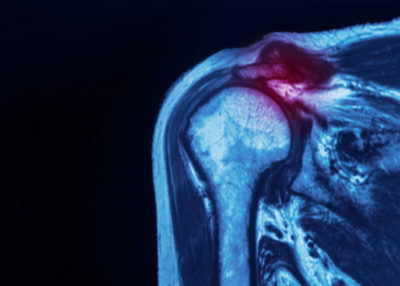
What is shoulder labrum repair or labral reconstruction?
The glenoid labrum is one of the primary stabilizers of the shoulder joint. The labrum keeps the humeral head from dislocating from the glenoid fossa or socket. The labrum can be traumatically injured (dislocation, fall on outstretched arm) or from repeated use (throwing, swimming).
Labral repair is a surgical technique performed on the shoulder to treat labral tears. This procedure is performed arthroscopically. However, severe injuries to the labrum can require an open surgical approach. The goal of labrum repair is the restoration of labrum integrity and function. In most cases, the labrum is torn away from the bony portion of the glenoid socket. Repair of the labrum back to its native bony insertion is the goal of this procedure. Riley J. Williams, orthopedic shoulder surgeon, serving Manhattan, Brooklyn, New York City, NY and surrounding areas, has extensive experience in performing shoulder labrum repairs and other shoulder procedures.
How is a shoulder labrum repair performed?
Shoulder labrum repair is an arthroscopic minimally invasive procedure that is performed on an outpatient basis. Light sedation and regional anesthesia is used for this surgery. The goal of surgery is the reattachment of the labrum to the bony glenoid socket. Specialized devices (anchors) are used to secure the labrum back to its native location. More severe labral injuries may require open surgery, which utilizes a larger single incision in the shoulder. Open surgery for labrum repair is rare but sometimes necessary for a successful outcome. Dr. Williams will discuss how the labrum will be repaired with the patient prior to surgery.
What are the risks?
Complications from shoulder surgery are rare. Postoperative issues such as bleeding, infection or persistent numbness may occur following labrum repair. Stiffness can also occur if the patient does not actively participate in the postoperative exercise regimen and rehabilitation.
How long does it take to recover?
Labrum repair patients go home the same day as their surgery. A sling is worn for the first 7 days following surgery; the sling is recommended for outdoor activities for another week. A return to work is possible within 1-2 weeks after surgery; light movement commences immediately following surgery. Physical therapy typically lasts approximately 8 weeks. A full recovery can take approximately 3-4 months.
For additional resources on shoulder labrum repair, labral reconstruction or to have your shoulder pain evaluated, please contact the office of Dr. Riley J. Williams, orthopedic shoulder surgeon serving Manhattan, Brooklyn, New York City, NY and surrounding areas.
Shoulder Expert

The shoulder is a ball and socket joint with a large range of motion. The shoulder is also one of the most complex joints in the body, capable of rotation, lifting, extension and flexion. Common conditions or injuries of the shoulder include shoulder instability, rotator cuff injuries and shoulder dislocations. Shoulder specialist, Doctor Riley J. Williams provides diagnosis as well as surgical and nonsurgical treatment options for patients in Manhattan, Brooklyn, New York City and surrounding areas who have sustained a shoulder injury or are experiencing shoulder pain. Contact Dr. Williams’ team today!
What is the anatomy of the shoulder?
The shoulder is a ball and socket joint which connects the humerus (upper arm), scapula (shoulder blade), and clavicle (collarbone). It is one of the largest joints in the body and is also one of the most complex. The shoulder consists of two main joints, the acromioclavicular joint, and the glenohumeral joint. These two joints work together, allowing for movements such as rotation, extension, flexion, and lifting. Dr. Riley J. Williams, orthopedic shoulder specialist, has years of experience diagnosing and treating patients in Manhattan, Brooklyn, New York City, NY and surrounding areas who have experienced an injury or an unusual condition of the shoulder.
What makes up the shoulder?
The shoulder is a highly complex joint and consists of several bones. These bones include:
- Clavicle: The clavicle attaches the body trunk to the arm. It is an “S” shaped long bone that supports the anterior shoulder and stabilizes the shoulder girdle.
- Scapula: The shoulder blade is a large, flat bone that forms the bulk of the shoulder joint bony anatomy. The scapula is the origin and attachment point for ligaments and muscles that are vital for shoulder function. It has three processes: the acromion process, the spine, and the coracoid process: these act as the muscular attachment points.
- Humerus: the humerus attaches the forearm to the rest of the shoulder. The top of the humerus fits snuggly into the glenoid cavity of the shoulder, making it a ball-and-socket joint, which allows for free movement and rotation of the arm. This ball and socket joint is also called the glenohumeral joint.
These bones come together to form three important joints. The acromioclavicular joint is formed between the scapula and the clavicle. The sternoclavicular joint joins together the clavicle to the breastbone and helps to stabilize the shoulder. Finally, the humerus and the scapula are joined together to form the glenohumeral joint, which is the main joint in the shoulder. Along with the bones, the shoulder has many ligaments that allow for movement and stabilization.
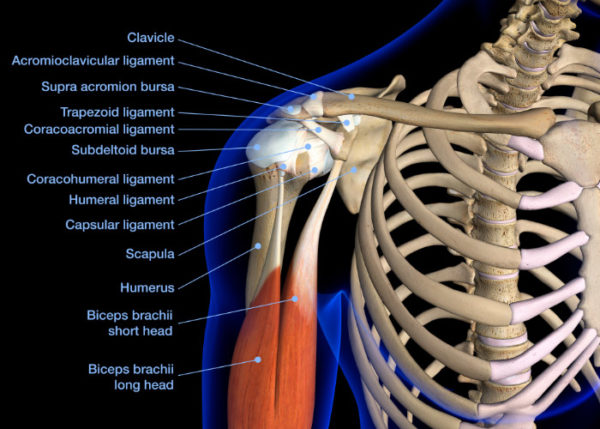
What are other important shoulder structures?
Other important structures that make up the shoulder joint include:
- Glenoid Labrum: a cartilage structure that helps keep the ball-and-socket joint of the shoulder stabilized. The labrum is a stabilizer or bumper for the glenohumeral joint and is responsible for keep the humeral head within the joint socket.
- Rotator cuff: this tendon surrounds the top of the humeral head and is attached to the rotator cuff muscles: subscapularis, supraspinatus, infraspinatus and teres minor. These muscles that stabilize the shoulder socket and allow for facilitate glenohumeral joint movement.
- Bursa: a fluid-filled sac in the joint that reduces friction and allows for smooth movement of the shoulder. The subacromial bursa, when inflamed, can be a source of shoulder pain.
- Articular Cartilage: Covers the ends of the bones and enables the smooth movement of the bones in apposition to one another within the joint.
What common shoulder injuries does Dr. Williams treat?
The shoulder is extremely complex and allows for a large range of motion. Many actions, especially those of athletes in high-impact sports, can cause the shoulder to become injured or damaged. Dr. Riley J. Williams has years of experience diagnosing and treating various shoulder injuries including:
- Biceps tendon tears (proximal and distal)
- Shoulder instability
- Shoulder dislocations
- Labrum and SLAP tears
- Shoulder Impingement
- Rotator cuff injuries
- Clavicle fractures
- Shoulder joint Arthritis
- AC joint separation and arthritis
- Coracoclavicular ligament injuries
The flexibility and range of motion of the shoulder makes this ball and socket joint susceptible to injury. It is important to seek out a specialist who has a proven track record of successfully treating shoulder conditions and injuries. Dr. Williams has an excellent track record and is known as one of the best choices in New York for shoulder treatment.
For more information on shoulder anatomy, or for additional resources on causes of shoulder pain or if you’ve experienced an injury, please contact the office of Riley J. Williams, MD, orthopedic knee surgeon serving Manhattan, Brooklyn, New York City, NY and surrounding areas.
Elbow Impingement Specialist

Are you experiencing sudden and sharp pain in the elbow with a decrease in range of motion? If so, you may have loose bodies in the elbow that are causing elbow impingement. Weightlifting or heavy physical labor can cause loose bodies in the elbow that can also lead to locking or catching of the elbow. Elbow loose bodies specialist, Doctor Riley J. Williams provides diagnosis as well as surgical and nonsurgical treatment options for patients in Manhattan, Brooklyn, New York City and surrounding areas who are experiencing loose bodies in the elbow and elbow impingement. Contact Dr. Williams’ team today!
What are loose bodies in the elbow?
The elbow is a hinge and pivot joint that is formed by the intersection of three bones: the humerus (upper arm bone), the ulna (forearm bone on the pinky side), and the radius (forearm bone on the thumb side). The surrounding muscles, tendons, and ligaments of the elbow allow the arm to bend at the elbow, much like a door hinge, as well as twist and rotate the forearm. A slippery white connective tissue, known as articular cartilage, covers the ends of these bones and enables them to painlessly glide over one another during joint movement. Physical activities where substantial stress is placed on the elbow joint, such as weightlifting or heavy manual labor, can cause early degeneration of the articular cartilage. Frequently, small fragments of articular cartilage or bone can become detached and left to “float” in the intra-articular (joint) space. Elbow fractures or osteoarthritis can also generate loose bodies in the elbow. Dr. Riley J. Williams, orthopedic elbow specialist serving patients in Manhattan, Brooklyn, New York City, NY and surrounding areas, has the knowledge and understanding, as well as substantial experience, in treating patients who have experienced loose bodies in the elbow.
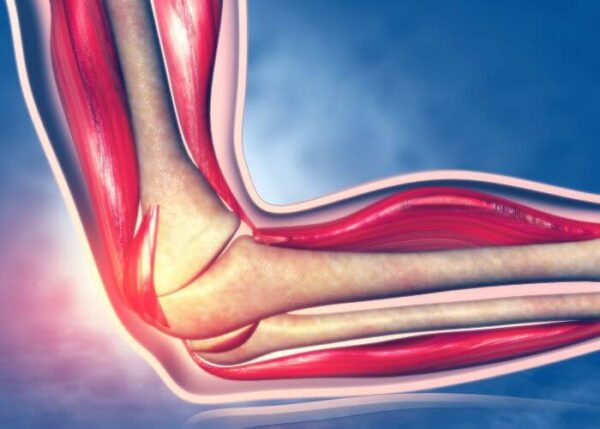
What are the symptoms of loose bodies in the elbow?
These bone or tissue fragments can become lodged within the joint space and cause various symptoms. Some common complaints of patients with loose bodies in the elbow include:
- Elbow pain that can be sharp or sudden
- Decreased range of motion of the affected elbow
- Elbow stiffness
- Mechanical “catching” or “locking” sensation with joint movement
How are loose bodies in the elbow diagnosed?
Dr. Williams will obtain a comprehensive medical history, to include any elbow injuries or a history of elbow conditions, followed by a thorough physical examination involving specific elbow movements and tests. Diagnostic imaging studies, such as x-rays and magnetic resonance imaging (MRI), are helpful tools in confirming a diagnosis of loose bodies. These imaging techniques can also identify any additional damage to the other structures of the elbow joint.
What is the treatment for loose bodies in the elbow?
Non-surgical treatment:
Initial treatments for a patient with confirmed loose bodies in the elbow may begin with conservative therapies. A combination of rest, ice, and non-steroidal anti-inflammatory medications (NSAIDs) can be used for pain and inflammation management. A corticosteroid injection may be administered directly into the elbow joint if oral medications fail to alleviate symptoms.
Surgical treatment:
If patients have multiple loose bodies, or conservative therapy is unsuccessful, surgical intervention may be needed. Removal of elbow loose bodies is achieved through a minimally invasive surgical procedure that is performed with a small camera (arthroscope) and specialized surgical instruments. Dr. Williams will perform a thorough inspection of the joint to visualize and remove the loose pieces. He uses the imaging studies as a guide to find the floating bodies. Dr. Williams prefers this arthroscopic surgical procedure as the risks of blood loss and infection are reduced and the trauma to the surrounding structures is limited thereby decreasing recovery time.
Most patient will be placed in a sling for 5-7 days after surgery. Physical therapy starts one week after surgery. PT will be needed for approximately six weeks after surgery.
For more information on loose bodies in the elbow, or the excellent treatment options available, please contact the office of Dr. Riley J. Williams, orthopedic elbow specialist serving Manhattan, Brooklyn, New York City, NY and surrounding areas.
